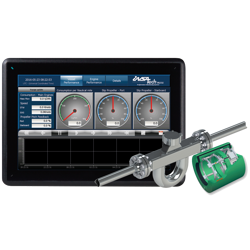How the Insatech Performance Monitoring System (PMoS) Works
1. Real-Time Data Acquisition and Crew Awareness
The Insatech Performance Monitoring System (PMoS) provides deep, immediate insight into your vessel’s operation. Its core function is to gather high-fidelity sensor signals, processing and displaying real-time performance data on the bridge, in the engine control room, and at headquarters for organizational benefit.
Use the PMoS to achieve continuous operational improvement by:
-
Increasing crew awareness and knowledge of efficiency.
-
Reducing fuel consumption and operational costs.
-
Identifying consumption trends over time.
-
Improving maintenance planning and scheduling.
2. Direct Measurement of Fuel Efficiency (SFOC)
The PMoS uses direct measurement principles for ultimate accuracy. By installing highly accurate mass flow meters (typically before and after the engine/generators), fuel consumption is monitored closely in real-time.
Direct Fuel Efficiency Calculation:
When consumption data is combined with measurements of actual speed and position (from the speed log and GPS signals), the system calculates the vessel's true fuel efficiency.
For the most detailed readings, the PMoS integrates comprehensive data from onboard sensors, enabling the calculation and visualization of advanced Key Performance Indicators (KPIs) for engine and hull performance.
3. Key Performance Indicators (KPIs) Calculated
The system transforms raw sensor data into essential operational metrics:
| Performance Metric |
Unit |
| Specific Fuel Oil Consumption (SFOC) |
[g/kWh] |
| Fuel Consumption |
[ton/hour] |
| Fuel Oil per Nautical Mile |
[kg/Nm] |
| Shaft Power |
[kW] |
| Torque |
[kN] |
| Slip |
[%] |
| Shaft Rotation |
[rpm] |
| Speed |
[Knots] |
| Weather Influences |
|
4. Data Processing and Headquarters Integration
All measurements from the Performance Monitoring System are sent via Modbus signals to a central collecting and processing cabinet. Here, the performance data is calculated, logged, and displayed on an intuitive touch screen interface.
Secure Data Link Option:
-
A dedicated data link option facilitates seamless data transfer to headquarters.
-
This link utilizes two databases: one on board the ship and one at headquarters.
-
Data is sent at a chosen frequency. If the ship loses internet connection, data is automatically stored and transmitted once the connection is re-established, ensuring zero data loss.
5. Transforming Data into Operational Profit
Once this comprehensive and verified data is acquired and displayed, it becomes a powerful tool for strategic decision-making:
-
Operational Efficiency: Optimise vessel operational efficiency (e.g., by testing trim optimization tools).
-
SEEMP Implementation: Implement and continually maintain the requirements of your Ship Energy Efficiency Management Plan (SEEMP).
-
Voyage Analysis: Create distinct KPIs and performance reports for each voyage.
-
Fleet Strategy: Evaluate the impact of new improvement projects before a fleet-wide roll-out.
-
Maintenance: Monitor the ship’s consumption trend over time to improve and prioritize your maintenance planning.
-
Crew Empowerment: Provide the crew with direct data insight to increase awareness and continuously improve knowledge of operational performance.















